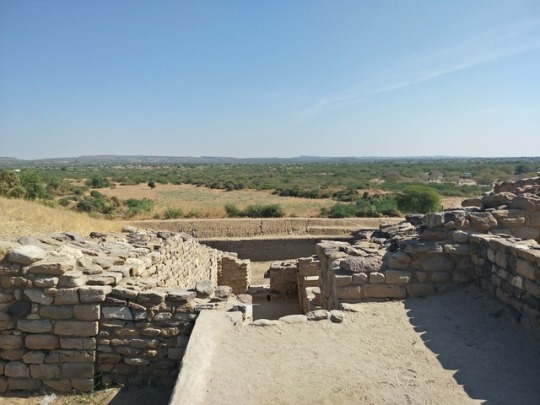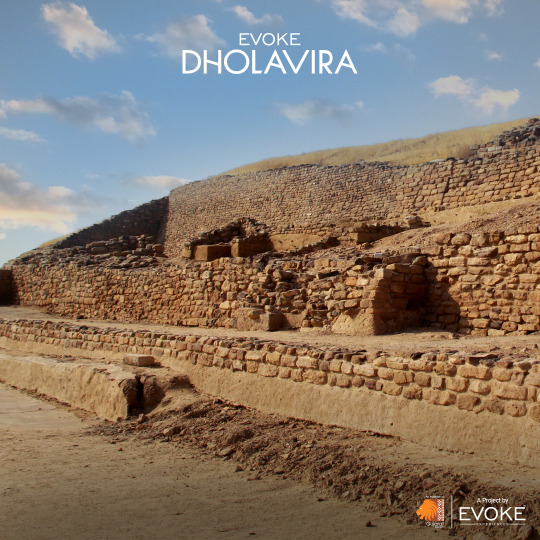#Evoke Dholavira accommodations
Text
Stunning Creations of Kutch: Glossy Finishes & Intricate Patterns

Explore the best places to stay in Dholavira with our comprehensive guide to top accommodations. Discover a range of options from budget-friendly stays to luxurious resorts, all ensuring a comfortable and memorable visit to this historic and archaeological site. Plan your perfect trip with our expert recommendations.
#EvokeDholavira#lacquerArt#kutchtextiles#kutchcrafts#indianart#kutchiwork#kutchiart#Dholavira archaeological site#Evoke Dholavira packages#Luxury Dholavira tours#Harappan civilization travel packages#Evoke Dholavira accommodations#Historical Dholavira trip#Luxury stays in Dholavira
0 notes
Photo

Historical places in Gujarat The state of Gujarat has played a significant role in history. The lands of Gujarat witnessed some brave kings and their rich heritage. Gujarat is also the birthplace of Mahatma Gandhi, the father of the nation, who initiated out various movements for India’s independence from here. The city of Ahmedabad, which is the heart of Gujarat has been recently titled as ‘World Heritage City’ by the UNESCO. Here are some of the places of historical importance and which one must visit and which would give you the feel of the rich ancient heritage and the struggle of Gujarat. Somnath: The Somnath temple is believed to be the first among the 12 Jyotirlingas of Lord Shiva. The shivling at the temple is believed to be ‘swayambhu’ or self-born, manifested in the temple. This temple was destroyed six times and rebuilt every time. The current structure of the temple, seventh reconstruction, is a magnificent edifice built in the Chalukya style of architecture by the master masons of Gujarat, known as Sompuras. Soma, the Moon god, is believed to have lost his luster due to a curse, and he bathed in the Sarasvati River at this site to regain it. The name of the town Prabhas, meaning luster, as well as the alternative names Someshvar and Somnath ("The lord of the moon" or "the moon god") arise from this tradition. You can also visit the beach, and the museum, close to the temple, which exhibits 1638 pieces from 7th to 15th century. Palitana: Located atop the Shetrunjai Hill, Palitana temple is one of the most sacred Jain temples in India and is known for its 3000 brilliantly carved temples. According to the records, there are approximately 108 large temples and 872 small shrines with about 7000 images total that have been built over 900 years from the 11th century by the Jain community. To reach the temple, one will have to climb 3800 steps. For the elder, palanquin (palki) service is easily available. The panoramic view of Palitana unfolds itself as one progresses to the temple. From the top of the temple, you can see the panoramic view of the Gulf of Cambay and countryside. Note: Devotees usually start their climb early in the morning and make their descent by evening as staying at night is not permitted. Dholavira: 250 km from the Bhuj district of Gujarat nestles an ancient town, Dholavira; that throws the light on the Harappan culture and its magnificent civilization. Second largest in India and fifth largest in the Indian sub-continent, this Harappan site the only place that marks the presence of Harappan culture from 2900 BC to 1500 BC. On a trip to Dolavira, you walk can pass through the sun-dried buildings, 5,000-year-old stepwell, ancient reservoirs. To reach Dolavira, you will have to drive for six kilometers from Ahmedabad. Accommodation options are very limited in Dolavira so; you can stay in Ahmedabad or head to Bhuj for the great Rann of Kutch. Laxmi villas palace: Built in 1890 as the private residence of Maharaja Sayajirao Gaekwad III, Laxmi Vilas Palace is indeed one of the grandest structures in India. Sprawling over an area of 700 acres, the palace is believed to be nearly four times the size of Buckingham Palace and features many buildings like Moti Baug Palace, Makarpura Palace, Pratap Vilas Palace and Maharaja Fateh Singh Museum building. It took Robert Fellows Chisholm, the head architect, twelve years to build this grand building. The property also has a Navlakhi stepwell, Maharaja Fatehgarh museum, and a small zoo, which was resting ground crocodiles. Ahmedabad: Finest creations or should I say the major tourists attractions in Gujarat are not only the efforts of years year rulers but also there is a little bit contribution of the citizenry as well. Pols are distinct residential areas that are unique only to Gujarat, and one can find their significant numbers in Ahmedabad. Ahmedabad has been titled the first “Heritage city” in whole India by UNESCO. There are nearly 174 pols in Ahmedabad, each featuring finest lovely wooden windows, brackets, magical balconies, khidkis, and chowks. Earlier pols were the preferred residence across the different sections of Gujarat society for the feeling of society and identity they evoke. Time has bestowed beauty to pol architecture of Gujarat, making them an ornament of world building. Gandhi ashram: Located on the banks of Sabarmati River, this abode of Gandhi is also known as Sabarmati Ashram. This Ashram, originally called Satyagraha Ashram, holds a special mention in the archives of India as a number of freedom movements were planned here between 1917 to 1930. Mahatma Gandhi also trained activists here to join his movements like Swadeshi movements, non-violence and civil disobedience. Gandhi’s poignant, Spartan living quarters are preserved in Sabarmati Ashram, and there’s an open-air museum that presents an informative and moving record of his life and teachings. The Sabarmati Ashram was also the starting point of the very famous and important movement of history, The Salt March to Dandi which played a significant role in leading India towards independence. Sun temple: Built in 1027 AD, Sun temple is one of the surviving Indian shrines dedicated to God Sun and stands as an epitome of the exquisite Hindu temple of Solanki dynasty. The temple is divided into three parts, which are perfectly aligned from east to west, in accordance with the deity passage of the sun. Inside the temple complex, you can see a suryakand or stepwell, prayer hall (also known as Sabhamandapa) supported on 52 pillars and another room (Gudhamandara) that leads to inner sanctum called Garbhagrah. The temple is a sight to behold during the Modhera Dance Festival. Sun temple is located in the Mehsana district of Gujarat, and one can reach by car or bus ride from Ahmedabad. Polo forest: The temples of Polo, located near Vijaynagar, were built between 10th and 15th centuries under the Gurjara-Pratiharas and later the Rathores as a hiding place from enemies, citizens, angry wives, and even from the sun. While there are number of medieval temples in the polo region of this period, the most notable ones are Sarneshwar temple (still in use), Lakha Dera Jain temple and Shiv Shakti Mandir. Structure and design of the temples reveal Islamic traces in the use of domes and lattice screens; it also follows the layout of Traditional Hindu temples. To reach the temples, you can take a bus or private taxi from Ahmedabad, which is hardly 160 kilometers away. Jeeps are also available from Idar, a town in Sabarkantha, which is 56 km from Vijaynagar. Jeeps would take you till the Polo campsite only; thereupon you will have to trek in the forest to explore the temple. There is only one homestay available at the Vijaynagar. Lothal: Somewhere like Dholavira, Lothal is also a significant site of the Indus Valley civilization excavated in India. Here, you can see a tank, which is believed to be a dry dockyard and is connected by the channel to the old course of the Sabarmati River. To know the place better you can also visit the museum, which showcases 5089 products unearthed from the evacuation like terracotta ornaments, shell and ivory objects, replicas of seal and sealings, tools and potteries yielded from excavations, copper and bronze objects animal and human figurines, weights, etc. To reach Lothal, you can hire a taxi from Ahmedabad and go for a long day trip or travel by train till Gandhigram and thereupon take a bus. Champaner: The deserted city of Champaner, a UNESCO world heritage site, is located in the foothills of Pavagadh. With some area perched on a rocky hilltop and bristling with forts, mosques, temples and palaces, Champaner-Pavagadh Archaeological Park looks like something out of a children’s storybook when it’s seen from afar. A major part of Champaner lies in ruins today, with the remains of many old mosques and palaces reflecting a blend of Islamic and Jain tradition. Also here you can find many Chalcolithic Indian Sites from the Stone Age era. Here one can find eleven different types of heritage monuments belonging to 16th century like tombs, gateways, mosques, temples, fortresses and walls, palaces, and pavilions, helical wells, custom houses. Kevda Masjid and Cenotaph, Jami Masjid, Lila Gumbaj Ki Masjid, Pavagadh fort, Lakulisa temple, and Helica Step-well, are some of the famous places to visit in Champaner-Pavagadh Archaeological Park. The Champaner complex is hardly 50 km away from Vadodara, thus, can be a good option for a weekend gateway. Rani ki vav: Rani ki Vav- as the name says this step well was built by Queen (Rani) of Bhimdeva, Udayamanti. Constructed in the 11th century to preserve ground water, Rani ki Vav came into limelight in 1972 when the area was fully earthed. The main highlight of the stepwell is that its walls that are profusely ornamented with figurative motifs and showcases images of various god and goddesses and their consorts from the Hindu Pantheon. The central part of each storey contains the primary sculpture. Winter is the best season to visit Rani ki Vav as you can enjoy the light shows, cultural events and exhibition at the Rani ki Vav Festival. Dwarkadhish temple: One of the four Dhams (divine abodes of India) and Sapata Turis (seven sacred cities), Dwarkadeesh Jagat Mandir doesn’t need any introduction. The word ‘Dwarka; is made of two words- ‘dwara’ meaning road, and ‘ka’ implying eternal significance. Going by the mythological records, Dwarka was the kingdom of Lord Krishna, and he stayed there for quite an extended period. This five storey temple stands on 72 pillars, which according to the science of archeo-astronomy, is some immense significance. The sandstone plinth and walls of the temples are embellished with panels depicting dancers, elephants, musicians and celestial beings. Along with Jagat Mandir, you can also visit the nearby temples like Bet Dwarka, Okha, and shrines dedicated to Rukmini (Lord Krishna’s Wife), Mirabai, Narsinh Mehta and Shank Narayan. Contact justwravel to plan your itinerary for your trip into history. "Kuch din to gujaro Gujarat mein"
0 notes
Text
Experience Culinary Delight at Evoke Dholavira: A Journey Through Local Flavors

Embark on a culinary adventure at Evoke Dholavira! We promise a delectable journey through local flavors that will tantalize your taste buds and leave you craving for more. Discover the rich and diverse cuisine of the region, expertly crafted to provide an unforgettable dining experience. Get ready to indulge in a feast of flavors at Evoke Dholavira!
#EvokeDholavira#dholaviraresort#indusvalleycivilization#dholaviratour#dholavirakutch#Dholavira archaeological site#Evoke Dholavira packages#Luxury Dholavira tours#Harappan civilization travel packages#Evoke Dholavira accommodations#Historical Dholavira trip#Luxury stays in Dholavira#Ancient city tours India#Evoke Dholavira bookings
0 notes
Text
Dholavira: Ancient UNESCO World Heritage Site of Gujarat

Dholavira, nestled in Gujarat's Kutch district, is a remarkable UNESCO World Heritage Site showcasing the ancient Indus Valley Civilization. With its well-planned streets, advanced water management, and intricate architecture, it offers a glimpse into a thriving urban center over 4,000 years ago. The site's layout, fortified walls, and evidence of extensive trade networks highlight its importance as a hub of commerce and cultural exchange. Today, Dholavira remains a captivating destination, drawing visitors worldwide to explore its ancient ruins and unravel its fascinating history.
#Dholavira archaeological site#Dholavira Tent City packages#Luxury Dholavira tours#Harappan civilization travel packages#Evoke Dholavira accommodations#Historical Dholavira trip#Luxury stays in Dholavira#Ancient city tours India#Evoke Dholavira bookings
0 notes
Text
Unearthing the Secrets of Dholavira: Exploring Indus Valley Artifacts

Embark on a journey through time as we delve into the mysteries of Dholavira. Ancient artifacts and stone remnants offer intriguing glimpses into the daily lives, culture, and civilization of the Indus Valley people. Join us in uncovering the fascinating stories buried beneath the sands of time. Experience the allure of Dholavira with the best accommodation options evoking its rich history.
#EvokeDholavira#dholaviraresort#indusvalleycivilization#dholaviratour#dholavirakutch#dholaviraheritagetourism#archeologicalsite#ancientindia#architecture#Dholavira archaeological site#Dholavira Tent City packages#Luxury Dholavira tours#Harappan civilization travel packages#Evoke Dholavira accommodations#Historical Dholavira trip
0 notes
Text
Dholavira Tour Packages | Evoke Dholavira Tent City

Book your Dholavira tour packages with Evoke Dholavira and choose from 1-night or 2-night packages featuring luxurious amenities and top-notch facilities. Experience the magic of Dholavira's ancient history with the comfort of modern accommodations. Our packages offer a perfect blend of exploration and relaxation, ensuring an unforgettable journey into the heart of the Harappan civilization. Make the most of your visit with expert guides, exquisite dining, and exceptional service. Start planning your adventure at Evoke Dholavira today!
#Dholavira archaeological site#Dholavira Tent City packages#Luxury Dholavira tours#Harappan civilization travel packages#Evoke Dholavira accommodations#Historical Dholavira trip#Luxury stays in Dholavira#Ancient city tours India#Evoke Dholavira bookings
0 notes
Text
Discover Evoke Dholavira: Luxury Stays Near Dholavira's Heritage Sites

Embark on a journey to Dholavira with Evoke Dholavira, where heritage meets luxury. Explore the best places to stay and experience the rich history and comfort near Dholavira.
#Evoke Dholavira#Luxury Stays Dholavira#Hotels Dholavira#Best Places to Stay Dholavira#Dholavira Accommodation#Luxury Lodging Dholavira#Dholavira Travel Experience#Dholavira Tourism#Explore Dholavira
0 notes
Text
Ahmedabad to Dholavira Tour: A Journey through Time and Comfort

Discover Dholavira's hidden history in Kutch and enjoy modern luxury at Evoke Dholavira, a great place to stay. This guide for the Ahmedabad to Dholavira tour combines history and comfort for a memorable trip.
#Dholavira#Kutch Region#Harappan Civilization#Ahmedabad to Dholavira Tour#Evoke Dholavira#Dholavira Accommodation#Historical Significance#Guided Tour
0 notes
Text
Serene Luxury Accommodation in Dholavira | Evoke Dholavira

Step into a haven of serene luxury Accommodation at Dholavira, where every detail is meticulously crafted to invite you to relax and unwind. Experience timeless elegance in a tranquil setting, surrounded by refined aesthetics and unparalleled comfort. Indulge in a harmonious blend of luxury and serenity, allowing yourself to escape the everyday and immerse in an ambiance designed for rejuvenation in the historic beauty of Dholavira.
#dholavira tourism resort#dholavira tour package#resort in dholavira#dholavira accommodation#dholavira places to stay#places to stay in dholavira#accommodation at rann of kutch
0 notes
Text
Discovering Dholavira: Unveiling the Secrets of Harappan Civilization
Nestled in the heart of the Kutch district, Dholavira is a testament to the ingenuity and foresight of the Harappan civilization. Known for its historical significance and archaeological marvels, Dholavira offers a unique glimpse into one of the world's oldest urban settlements. This Dholavira tourist guide aims to unveil the secrets of this ancient city, guiding you through its mesmerizing ruins and the remnants of a once-thriving culture.

The Journey to Dholavira
Dholavira, located in the arid landscapes of Gujarat, India, is accessible by road from major cities in Gujarat. The journey to this ancient site is as fascinating as the destination itself, with the rugged terrains of the Kutch offering a stark yet beautiful backdrop. Once you arrive, the sense of stepping back in time is palpable, as the ruins whisper tales of a civilization that mastered the art of living in harmony with nature.
Exploring the Marvels of Dholavira
Dholavira tourism is not just about exploring the ruins; it's about connecting with a civilization that was advanced beyond its years. The city is divided into multiple zones, including the citadel, the middle town, and the lower town, each showcasing the Harappan way of life. Notable places to see in Dholavira include the water reservoirs, which highlight the Harappans' expertise in water conservation, and the signboard, which bears one of the earliest examples of written language.
The archaeological site also offers insight into the town planning, architecture, and social hierarchy of the Harappan people. As you wander through the ruins, the strategic planning of the city, with its well-laid streets and expertly constructed drainage systems, becomes evident, showcasing the advanced urban planning skills of its inhabitants.
Embracing Dholavira's Tranquility
Beyond its historical and archaeological significance, Dholavira exudes a serene ambiance that captivates every visitor. The vast expanses of the surrounding desert, the stunning sunsets, and the clear night skies make Dholavira not just a place for historical exploration but also a retreat for those seeking tranquility amidst nature.
Accommodation in Dholavira
For those wondering about places to stay in Dholavira, Evoke Dholavira offers a comfortable and immersive experience. Nestled close to the archaeological site, the resort provides a perfect base for exploring the ancient ruins and soaking in the timeless beauty of the surrounding landscape. With well-appointed rooms and top-notch facilities, it ensures that your stay is both memorable and comfortable.
The best time to visit Dholavira is from October to March when the weather is cooler and more conducive to exploration. Ensure to carry water, sun hats, and sunscreen, as the area can get quite hot during the day. Hiring a local guide can greatly enhance your understanding of the site and its historical context.
Conclusion
Dholavira is not just a tourist destination; it's a journey back in time to one of humanity's earliest urban centers. Through its impressive ruins and museums, it tells the story of a civilization that, though ancient, was incredibly advanced. The tranquility of its desert surroundings, coupled with the rich historical tapestry, makes Dholavira a must-visit for anyone fascinated by history, archaeology, or simply the beauty of ancient cultures. And with accommodations like Evoke Dholavira, your trip to this timeless city will be as comfortable as it is enlightening.
#dholavira tourist guide#dholavira tourism#dholavira tourism places#places to see in dholavira#places to stay in dholavira#dholavira located
0 notes